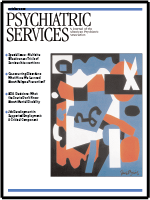Service Use by Asian Americans
In Reply: I thank Dr. Sevilla for emphasizing the fact that our article confines itself to describing the utilization experience of East Asians and other ethnic groups (of the total sample of 104,773 persons, 10,262 were identified as Asian Americans). Dr. Sevilla's letter highlights the need for better and more current information about access problems, because much of the information he provided is drawn from review articles (1,2) whose authors draw conclusions on access and utilization issues that are predicated upon research studies of questionable validity (3,4). These studies are a quarter-century old and not sufficient in scope or representativeness to justify resource allocation decisions. We all recognize the issue of language barriers, especially for new immigrants. It is most important that new information on this issue and other access and utilization issues address the unique as well as the shared needs of specific Asian-American subpopulations.
Lin and colleagues (4) tell us that the Asian population is as varied, if not more varied, in cultures and traditions as is the population of Americans with European ancestry. Our finding of significant utilization differences between East Asians, Southeast Asians, and "other" Asian subgroups (even after adjustment for the severity of illness) suggests that combining the experiences of these groups under the "Asian" umbrella presents an inaccurate picture. Given this observation, it would seem that there is a significant need to present Asian Americans' problems with access to services differentially as well. Dr. Sevilla correctly notes that a recent study of high-risk youths found that Asian Americans and Pacific Islanders (N=88) were less likely than youths from other ethnic groups to receive formal mental health services; however, the study does not help us target the specific Asian-American subgroup and thus more directly address its needs (5). I thank Dr. Sevilla for pointing to the need for better information on access to mental health services and hope that such research will better target disparities in equal opportunities for receipt and use of mental health services.
1. Chin JL: Mental health services and treatment, in Handbook of Asian American Psychology. Edited by Lee LC, Zane NWS. Thousand Oaks, Calif, Sage, 1998Google Scholar
2. Lin KM, Cheung F: Mental health issues for Asian Americans. Psychiatric Services 50:774–780,1999Link, Google Scholar
3. Lin TY, Lin MC: Service delivery issues in Asian-North American communities. American Journal of Psychiatry 135:454–456,1978Link, Google Scholar
4. Lin TY, Inui T, Kleinman A: Sociocultural determinants of help-seeking behavior of patients with mental illness. Journal of Nervous and Mental Disease 170:78–85,1982Crossref, Medline, Google Scholar
5. Garland AF, Lau AS, Yeh M, et al: Racial and ethnic differences in utilization of mental health services among high-risk youths. American Journal of Psychiatry 162:1336–1343,2005Link, Google Scholar



